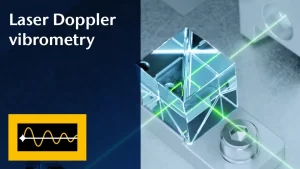Holographic interferometry features, advantages and disadvantages
Holographic interferometry is a technique that allows static and dynamic displacements of objects with optically rough surfaces to be measured to the optical interferometric precision (i.e. to fractions of a wavelength of light), These measurements can be applied to stress, strain, and vibration analysis, as well as to non-destructive testing and radiation dosimetry.
Holographic interferometry
Holographic interferometry can be used to detect the optical path length variations in transparent media, which enables, for example, fluid flow to be visualized and analyzed, It can also be used to generate the contours representing the form of the surface.
Holography is the two-step process of recording the diffracted light field scattered from the object and performing the image rendering, This process can be achieved with the traditional photographic plates or with the digital sensor array, in digital holography.
If the recorded field is superimposed on the live field scattered from the object, the two fields will be identical, If the small deformation is applied to the object, the relative phases of the two light fields will alter and it is possible to observe the interference, This technique is known as live holographic interferometry.
It is possible to obtain the fringes by making two recordings of the light field scattered from the object on the same recording medium, The reconstructed light fields may then interfere to give the fringes that map out the displacement of the surface, This is known as frozen fringe holography.
The fringe pattern form is related to the changes in surface position or air compaction, Many methods of analyzing these patterns automatically have been developed in recent years, Applications of holographic interferometry such as Laser vibrometry and Laser Doppler imaging.
Laser vibrometry
Laser Vibrometry by holographic interferometry has become commonplace, The local vibration amplitude can be assessed by fringe counting, By sequential imaging of frequency sidebands, the issue of fringe counting has been alleviated.
The side band order is a marker of the local amplitude of sinusoidal out-of-plane motion, Multiplexed measurements of optical sidebands enable quantitative measurements of out-of-plane vibration amplitudes much smaller than the optical wavelength.
Laser Doppler imaging
Holographic interferometry is very sensitive to allow wide-field, laser Doppler imaging of the optical fluctuations in amplitude and phase, either with the slow or fast camera, The slow (e.g. video rate) camera will record time-averaged holographic interferograms which will result in low-pass filtering of the optical fluctuation signal.
When you shift the frequency of the reference beam, the low-pass filter becomes the band-pass filter centered at the detaining frequency, Selective narrow-band detection and imaging can be performed.
This method permits micro-vascular blood flow imaging & wide-field measurement by detection of out-of-plane tissue motion, The wide temporal bandwidth of a high throughput camera can allow the wide-band detection & analysis of optical fluctuations, It can be used for pulsatile blood flow imaging.
Holographic Interferometry advantages
Holographic interferometry allows to record the whole thermal or concentration field by using the holographic interferometer, The observed area is not disturbed by the sensors or sensing heads to detect the local displacements, The light beams can be considered free from the inertia that enables to record the immediate events.
Holographic interferometry allows to visualize the distribution of thermal and concentration fields in shape-complex objects, The holographic interferometer is cheaper than the classical interferometer because it does not put high requests on the optical components (lenses and mirrors) quality.
The interferometric measurements enable the non-contact measurements, the deformation process is conditioned exclusively by the object characteristics, its embedding (fastening), and its loading, Holographic interferometry does not overtax the quality of recorded object surface, So, we can carry on the measurements on the investigated object whereas it is not necessary to produce any physically similar models.
Through the methods of holographic interferometry, we can compare the shapes of already non-existing objects and analyze them, The holography helps obtain a three-dimensional display of the object, that allows us to determine three components of the displacement vector from one holographic plate.
Holographic Interferometry disadvantages
The equipment for holographic interferometry is rather complex, expensive (cheaper than in classical interferometers), and limited by laboratory conditions, The dimensions of the investigated object are limited by the size of the objective viewing field, Larger deformations lead to the formation of non-distinguishable interference structure.
The method of holographic interferometry is possible to apply mainly in laboratories to ensure the stability of the holographic equipment (except the holographic interferometry in the impulse mode).
The experimental equipment for the object investigation should satisfy the specifications of the holographic interferometer respecting its dimensions and construction, If we use the real interferometric equipment, we must keep in view the deviation from the ideal interferometric system & rectify it by using the corrections.
In the interpretation of the holographic interferogram, it is necessary to measure the value at the edges by the sensors or determine them from the experiment character, That is the case of the holographic interferometry of diffusively reflecting objects interpretation, i.e. the loading force direction is not possible to determine.
During the interpretation of the holographic interferogram of diffusively reflecting objects, larger deformations lead to the formation of a non-distinguishable interference structure, When looking through the hologram , it is not possible to tell if the phase difference is positive or negative .
Hologram imaging technology features, advantages, and disadvantages




